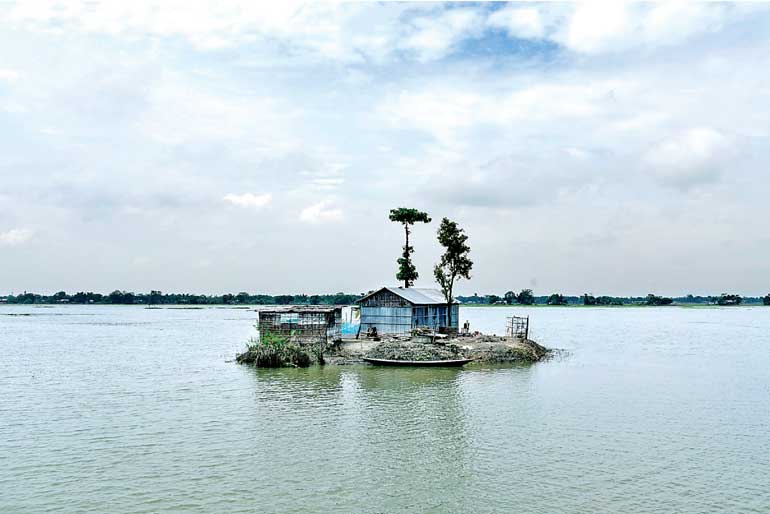Thursday Nov 20, 2025
Thursday Nov 20, 2025
Saturday, 8 October 2022 00:00 - - {{hitsCtrl.values.hits}}

There are still significant knowledge gaps around human mobility in the context of climate change, and a crucial need to expand the evidence base
 Research has clearly established the deep linkages and interconnections between climate change and human mobility across the world. Climate change can be an underlying driver of migration and disaster displacement, but it can also affect decision-making around mobility in indirect and multi-faceted ways. Understanding this complex nexus is critical to integrate mobility considerations into plans, policies, strategies, and laws as well as to support migrants, their families, and host communities.
Research has clearly established the deep linkages and interconnections between climate change and human mobility across the world. Climate change can be an underlying driver of migration and disaster displacement, but it can also affect decision-making around mobility in indirect and multi-faceted ways. Understanding this complex nexus is critical to integrate mobility considerations into plans, policies, strategies, and laws as well as to support migrants, their families, and host communities.
Climate-related human mobility in South Asia
Human mobility is an umbrella term that includes, among others, climate migration, disaster displacement, planned relocation, and human immobility. As the Sixth Assessment Report by the Intergovernmental Panel on Climate Change (IPCC) points out, “links between weather fluctuations (including extreme events) and human mobility are complex and conditional on socio-economic situations.” Furthermore, “climatic risks interact with economic, political, and social drivers to create risks to human mobility both directly (through the threat of physical harm and destruction of property and infrastructure) and indirectly (via adverse impacts on livelihood and wellbeing).” Climate-related migration is set to increase, but there are “major knowledge gaps preventing more detailed assessments,” including a lack of regional, sub-regional, national, and local-level evidence.
South Asia as a region is vulnerable to the impacts of climate change. Erratic monsoon patterns, temperature rise, and climate-related disasters—such as droughts, floods, storm surges, cyclones, or heavy rains—affect and often displace hundreds of thousands of people. The World Migration Report 2022 states that “Southern Asia’s average temperatures have been increasing over the last several decades and the subregion is now among the most vulnerable to the impacts of climate change, including rising temperatures; the subregion is affected by extreme and frequent weather events, torrential rains, and rising sea levels. […] Both rapid- and slow-onset disasters are important features in Southern Asia, often resulting in millions of displacements.”
The recent Asia-Pacific Migration Data Report 2021 estimates that under a pessimistic scenario, the number of climate migrants in the region could rise to 35.7 million people by 2050, potentially amounting to 1.6 of South Asia’s entire population. Even under a more optimistic projection, millions to tens of millions of people will be forced to move by the impacts of climate change.
To prepare for this trend, the report finds that “quantifying the impacts of climate change on the migration landscape is crucial” and highlights key challenges “associated with understanding and taking action on slow-onset climate impacts and migration issues.” Long-term environmental and climatic changes in particular, for example saline intrusion, soil degradation, or loss of ecosystem services, need to be further explored in connection to forms of human mobility. Similarly, non-economic losses and damages caused by climate change have strong but underexplored linkages to mobility both as a cause and consequence.
The value of data and evidence
The World Migration Report 2022 states that “the relationship between climate change and migration has clearly gained increasing visibility on the policy agenda over the last decade, and there is now much more awareness of the need to address this complex topic.” Climate change affects or exacerbates drivers of mobility related to food security, water security, economic security, energy security, personal security, and environmental security, but its exact consequences highly depend on existing resources, capacities, support systems, and policy environments. While much data on this has been collected, “significant knowledge gaps” still remain, and there is an “absence of harmonized data sets and of disaggregated data” in many countries around the world.
The IPCC report makes a similar observation: “Given the complexity of human migration processes and decisions and the paucity of long-term, reliable and internally consistent observational data on displacement and migration, the contribution of long-term changes in climate-related systems to observed human displacement or migration patterns has not been quantified so far,” with very few exceptions.
At a recent virtual workshop series on climate change and human mobility, the importance of data was highlighted by many of the speakers and attendees. Identified data needs include mapping different forms of human mobility and their connections to climate change across sectors; collecting detailed and disaggregated data on the community and household level; collecting data on informal and country-internal mobility; identifying cross-cutting and intersectional issues related to gender, youth, the elderly, special needs, or vulnerable groups; and having a good understanding of existing planning processes on all levels from individual to national.
Listening to the voices of those affected is vital to collect data in a participatory and inclusive way. Such data could then be cross-referenced with scientific research, climate projections, and socioeconomic indicators to identify existing movement patterns as well as anticipated ones. Towards this end, workshop participants brought up different solutions, for example developing quantitative and qualitative indicators and metrics on climate-related human mobility on the national and subnational level; mainstreaming these indicators and data points into regular data collection mechanisms; or conducting anticipatory assessments of the projected needs of migrants or displaced persons.
To effectively address climate-related human mobility and incorporate it into planning and policy processes in South Asia and beyond, there needs to be an understanding of its patterns and complexities. Interventions must be built on a solid evidence base, and cross-cutting issues must be identified and considered. In many cases, data or data collection mechanisms are already there, but they need to mainstream mobility indicators, be compiled, coordinated, and exchanged between different stakeholders. In other cases, evidence needs to be gathered, and there are new frontiers of knowledge to explore, for example regarding voluntary or involuntary human immobility.
As climate change is becoming a significant underlying factor that influences or shapes human mobility, it is increasingly important to understand the exact nature of this influence and find ways to support affected people, communities, and countries through evidence-based and inclusive processes on all levels.
(The writer works as Director – Research and Knowledge Management at SLYCAN Trust, a non-profit think tank based in Sri Lanka. His work focuses on climate change, adaptation, resilience, ecosystem conservation, just transition, human mobility, and a range of related issues. He holds a Master’s degree in Education from the University of Cologne, Germany and is a regular writer to several international and local media outlets.)